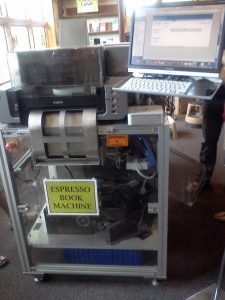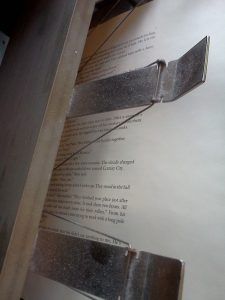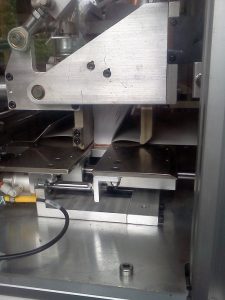I’m guessing most of you reading this have heard of the Espresso Machine. Simply put, it’s an ATM for books. You select the manuscript you want and the machine prints it up for you right there on the spot.
In theory, this is cool on a couple levels. For bookstores, it means they’ve got access to a much larger potential inventory. I think for most of us, when we go to a bookstore and get told “we can order it for you,” that’s usually the signal to go home and order what we want on Amazon. With an Espresso Machine, the bookstore gets to say “we don’t have it in stock, but we can print it up for you in fifteen minutes.”
That’s just a few steps off from replicator technology.
For writers, especially traditionally published authors, it means paperbacks never need to go out of print. There are tens of thousands of books out there that aren’t financially viable for a publisher to bring back (last numbers I heard said a book needs to sell over five thousand copies a year to be worth keeping in print), but could still gather random sales. And sales means income. Authors with a large back-catalog could suddenly be getting regular checks again when a dozen books sell twenty or thirty copies each. Not phenomenal money, but definitely better than the nothing the books are making when out of print.
All pretty nifty, yes?
Well, about six weeks back I was up at Village Books in Bellingham, Washington, and I got to take their Espresso Machine for a whirl. Not only that, their resident Espresso expert, Brendan, was willing to talk with me for about half an hour, going over the machine and the whole process from beginning to end. So I decided to get a copy of 14 through the machine and see what came out.
 The Espresso Machine at Village Books is one of the first ones put out, and thefirst one on the west coast. It’s about two years old (on a three year, rent-to-own lease), and Brendan’s trying to convince the owners to trade up to the new model in a year when the lease is up. The newer one has worked out some small bugs and also goes a bit faster (most books are done in closer to ten minutes). Keep that in mind as you read through this.
The Espresso Machine at Village Books is one of the first ones put out, and thefirst one on the west coast. It’s about two years old (on a three year, rent-to-own lease), and Brendan’s trying to convince the owners to trade up to the new model in a year when the lease is up. The newer one has worked out some small bugs and also goes a bit faster (most books are done in closer to ten minutes). Keep that in mind as you read through this. First off, the machine is a bit more cobbled-together looking than you might expect. The front is a terminal. The back looks a lot like an oversized photocopier, the type you’d find in an office or Kinkos. In between is a glassed-in section with robot clamps, hydraulic blades, and shifting platforms that assemble the book. It’s kind of like a computer and a printer having a threeway with one of the robots from Tony Stark’s workshop.
So, Brendan ordered a copy of 14 for me. It’s not a book that’s stored on the machine’s hard drive, so it takes a few minutes just to download that file (they’re kind of big).
It’s also worth noting that this download costs almost nine dollars. This is where pricing comes into play. The final cost of the book is based off download costs (if any), raw materials (the Espresso machine goes through high-end paper just like a copier, so big books cost more than small books), and the store’s profit margin. In the case of 14, this actually means the final book ends up costing just shy of $19.00 through the Espresso (four bucks over the publisher’s suggested retail price). There are lots of public domain books that are inexpensive, though, and it also works well for some of their more direct publishing relationships (local authors, local schools and colleges).
 The cover gets printed first. It’s usually getting the most color and it’s on glossy paper. It ends up face down at the bottom of the assembly area.
The cover gets printed first. It’s usually getting the most color and it’s on glossy paper. It ends up face down at the bottom of the assembly area. Then the machine starts printing pages. It’s just like watching a copier or high end computer printer. And, just like these machines, sometimes there are mess-ups. One page comes out just a little off, as does the next and the next and the next, and suddenly instead of a neat stack of paper there’s a broad fan. This actually happened on the book the machine was printing right before mine. Brendan had to pause everything and shuffle things back into place. He does try to check on the machine while it’s working, but every now and then something sneaks by.
 Once the pages are all printed, the next step is the gluing. The manuscript is squeezed together and the machine paints a stripe of hot glue along it. Then the whole thing is pressed down into the cover, which is pressed down into a gap in the floor of the machine (again, all of it shifting and adjusting in a very Iron Man way). The robot arm presses from above, the gap clamps tight from below, and the pages are glued into the cover. On rare occasions the machine puts down too much glue and makes a mess of things, and if that does happen it could mean starting over.
Once the pages are all printed, the next step is the gluing. The manuscript is squeezed together and the machine paints a stripe of hot glue along it. Then the whole thing is pressed down into the cover, which is pressed down into a gap in the floor of the machine (again, all of it shifting and adjusting in a very Iron Man way). The robot arm presses from above, the gap clamps tight from below, and the pages are glued into the cover. On rare occasions the machine puts down too much glue and makes a mess of things, and if that does happen it could mean starting over. Once the glue’s been given a few minutes to dry, the machine moves on to cutting. All of this is printed on 8 1/2” x 11” paper, so it needs to be snipped down to size. The arm spins the book, a new opening appears in the floor of the machine, and a hydraulic blade shears off the excess material. It’s kind of scary how effortlessly the machine cuts through almost 200 sheets of paper. The book’s rotated and cut until all the page measurements are correct.
And that’s it. The arms carry the book over and drop it out a slot on the right side of the machine. At the end, it took just shy of fifteen minutes from placing the order until the finished book pops out.
For the record, the book on the right is one of the regular copies available through Amazon. The book on the left is the one Brendan printed up for me. They’re not identical, but they’re pretty close. It is interesting to note that the cover on the Espresso copy has notably faded, just in the two months since I bought it (originally there was almost no difference).
Final thoughts…
The Espresso Machine’s pretty damned impressive, especially when you consider this is a first-gen machine. It’s not as smooth, simple, and flawless as we were all led to believe, but it’s not far off from that, either. I’d compare it, technology-wise, to the grocery store self-check out terminals, the ones that at first still needed a clerk standing right there to deal with the issues that kept popping up. In just a few years, those stations have made some leaps forward, and it’s not hard to believe the Espresso Machine’s going to do the same thing.



